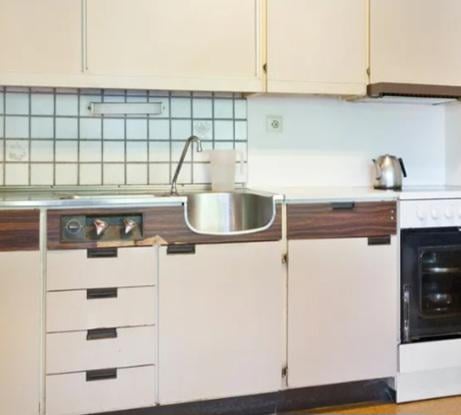
Hey guys!
Just a lurker here, no moving, no job seeking, no holidays, just curious…
I was scrolling on finn.no for a house for day dreaming and I've seen those sinks quite a few times. Is there a reason for it? Like fish or game cleaning? Something historical? For exemple, if it's a regional kind of thing, this house is in Stranda.
I've never seen it anywhere else and, well, I'm puzzled!
by AnnaRocka
19 comments
It makes it easier to pee in the sink if the bathroom is not vacant.
It is for making it easier to fill a bucket and get it in and out of the sink.
We call it an “utslagsvask”. I can’t find any good translation, google suggests “washout” and “drain”. Directly translated its something like “empty-out-sink” for easy access with buckets when washing floors.
Damn, I completely forgot about this. My grandparents also had a sink like that. Thank you for giving back the memories 🙌🏻
You find them mostly in older kitchens. Not very popular in newer kitchens. Not sure if they make them anymore.
We had those exact kitchen units and that sink in our council house in North East Scotland in the eighties. My sister and I used the “bucket sink” for washing our hair.
Easier for when you need to take a quick piss and can’t be bothered using the toilet. Quick and easy
Something historical yes! Memories.
Thank you all for your answers! So it’s either to take a piss OR make it easy to carry a far more than i could imagine number of buckets of water out of it!
I love these sinks, my grandmother had one, it made hair washing only a easy task. I miss it everytime I colour my hair at home.
No no no no its for shiting in
I only just got rid of mine, much better than the new ikea ones. Only issue was if you emptied something into the lower sink, had a tendancy to fly out the front. Finding a basket to fit that lower part for drying plates become an impossible task.
Lack of this specific sink design in newer kitchens, is connected to not wearing shoes indoors, even as a guest/visitor. Who wants to wash the floors daily?
Also, the space used for the «utslagsvask», is often used for a dishwasher instead, when old kitchens units are replaced.
Ahh i had one like that i could only imagine it was for washing your ass. Perfect for for someone sitting in it. 😆
Love a good utslagsvask, but now that houses are more modern the more logical place to put it would be the laundry room.
Not only useful for emptying and filling buckets, you can use it to soak pinnekjøtt, soak salt fish, soak stockfish (not recommended, it gets a bit smelly), pissing in if the bog is occupied, soak clothes with tough stains, filling it with ice and using it as a wine cooler in preparation for arriving guests…
Of course you could solve those problems in other ways, but it’s a fool move to not have a sink in your laundry/cleaning room, so you might as well have a large sink that’s big enough to fill a bucket.
r/sinkpissers
I have a sink like that. It really can soak your crotch if you pour said bucket back in too fast
I’ve only ever found this in really old houses, also those houses always have the weird hot/cold water levers/knobs on the sinks that I despise
I agree with all the answers given here. I think, historically, when people first got running water in their kitchens, it would be a single tap, located over a simple kind of sink, made of iron and hanging on the wall. You would use the sink as a drain for all kinds of things, filling and emptying buckets and coffee pots etc. When washing the dishes, you would fill a small tub with cold water from the tap and mix it with warm water boiled on the stove. After the washing was done, you would empty the tub into the sink. When the kitchens gradually got more modern, you would get a modern kind of steel kitchen sink for washing the dishes, in addition to the old iron one. In the 1950s the kitchens got even more modern, and you would get the two different sinks side by side, like in your picture. The drain sink on the side would be used for more dirty work, like rinsing fish or vegetables, while the other sink was reserved for dishwashing. When the dish washing machine became normal, the house work got less labour intensive and the kitchen became more of a living area than a working space, the practical, but not so pretty drain sink gradually went out of use and the kitchen space was used for other things.
Comments are closed.